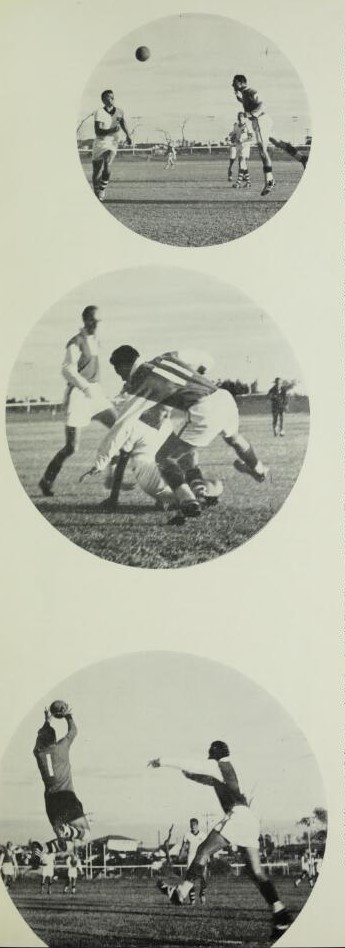Ian Syson notes the following is excerpted from MIMAG June 1962:
Today, soccer is big business all over the world. Fantastic sums of money are paid on transfer of top quality players from one team to another. Literally millions of pounds are spent annually on football pools, based on the results of league and cup matches. Players are ‘stars’ and ‘specialists’, and are treated as such.
In Australia, soccer, started as early as 1880. In 1882 the New South Wales Soccer Association was formed, quickly followed by other States. The Australian Football Association was formed in 1921. Australia entered the international field in 1922. Competitive matches between States began in 1929 when England presented a Soccer Trophy. After the Second World War Australian teams entered both Olympic and World Cup competitions.
Soccer was played in Mount Isa right from the early days, although there were no organised form until approximately 1936 [probably an error, see 1934 above]. During the war many matches were organised with armed services teams and competitive play was wide spread.
The game lost its organised form for some years after the war, but in 1953, organised soccer was again instituted with its clubs playing knock-out games. These were Scotties, Pannonia, St. Helens and B.S.D. The following year the Mount Isa Soccer Association was formally inaugurated and the popularity of the game was high. During a two-day soccer carnival, teams from Ingham played against Mount Isa. Five local teams were in the field. Touring was again in vogue in 1955 when an Isa representative team went to play in Townsville. The game continued to climb in popularity in 1956 and Wellington Oval became the venue for Sunday matches. Six clubs played that year. The two new ones were Mt. Oxide and Shamrocks, formed from the old B.S.D. Club. Townsville returned the previous year’s visit and lost 4-1 to Mount Isa.
Today soccer football continues to thrive. The year 1961 saw an upsurge in junior soccer when a representative team of lads under 16, mainly from the junior champions “Sparta” toured Brisbane and Ipswich with considerable success. Cor Valkenburg, a former Pannonia goalie from the early days, travelled with and managed the team. This year saw the introduction of “B” division matches and the further development of junior soccer, with more and more schools interested in competitive play. Improved conditions at Wellington Oval and the promise of floodlighting for evening play will see further expansion of interest in the game. The main clubs are showing a keen interest and the omens are good for a season of really fine sport.
The season officially opened on Easter Sunday with a match between well balanced teams representing the British Commonwealth on the one hand, and the rest of Europe on the other.
League play this season centres on four main teams, Scotties, Brittania, Pannonia and Concordia. Players like Joe Mezes of Pannonia, Peter Houghton and Joe Wicks of Brittania, Peter Wendt of Concordia and Adolph Nimaus and Bert Harding of Scotties, were well worth watching last year and are proving as good again this season. Bobby Moore of Scotties, continues to amuse as well as to shine. All sections of the community are gloriously intermingled in these teams, with the Company’s Mining Department seemingly supplying the bulk of the stars. Alex Pavusa and Bobby Cairns are our leading referees in the current season.
Ian Syson is one of Australian Football’s foremost historians. Ian’s ground-breaking research and more information related to football in Mount Isa can be found at his football history site neos osmos.

1966: Concordia won the league competition and then folded at the end of the season. United were runners up, then: (3) Scotties; and (4) Irish.
While Scottish side Celtic were making history winning the European Cup, the influence of the Scots on Australian football continued.
1967: Irish (won the league competition and the Mt. Isa ‘Scottish Cup’). Scotties were runners up. Then: (3) United; (4) Independent; (5) International.



We acknowledge the Traditional Custodians of the land on which the events presented in this digital history occurred and acknowledge that sovereignty was never ceded. We recognise Aboriginal and Torres Strait Islander peoples and their continuing connection to land and waterways as well as their rich history of sports and significant continuing contribution to football.